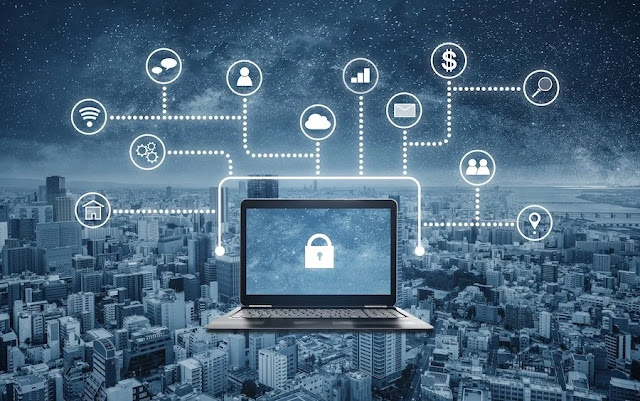Protecting your online assets is more crucial than ever in the current digital era. People and corporations need to act proactively to defend their digital assets as cyber attacks become more common and sophisticated.
 |
The rise of cyber threats such as hacking, phishing, and malware, it is essential to take steps to protect your digital assets. In this article, we will provide a comprehensive guide on how to keep your digital assets safe and secure.
Understanding Digital Assets:
Every type of data that is saved or delivered digitally is referred to as a digital asset. Together with financial and personal data, it may also comprise trade secrets and intellectual property.
Digital assets may be accessible online and can be found on many different platforms, including computers, smartphones, and tablets.
Common Threats to Your Digital Assets:
There are several ways cyber criminals can target your digital assets. Some common threats include:
1- Phishing scams
2- Ransomware attacks
3- Malware infections
4- Social engineering attacks
5- Weak passwords
6- Unsecured Wi-Fi networks
7- Outdated software and systems
2- Ransomware attacks
3- Malware infections
4- Social engineering attacks
5- Weak passwords
6- Unsecured Wi-Fi networks
7- Outdated software and systems
How to Protect Your Digital Assets in 2023:
Use both uppercase and lowercase letters, as well as a mix of numbers and special characters. Avoid using terms like "password" or "123456" that are simple to guess.
Enable Two-Factor Authentication:
With two-factor authentication, users must present two different pieces of identity in order to access an account. A password and a code may be included in this and communicated through email or mobile device.
Using two-factor authentication can help keep your accounts safe from illegal access.
Keep Software and Systems Up to Date:
Security patches and bug fixes are frequently included in software and system upgrades, helping to safeguard your digital assets. Regularly update your operating system, antivirus program, and all other apps.
Use Antivirus and Anti-Malware Software:
Your devices may be protected against virus and malware attacks with the use of antivirus and anti-malware software. These applications check your devices for harmful malware and eliminate any dangers they find.
Be Careful of Phishing Scams:
Scammers use phishing to get sensitive information such as passwords and credit card numbers.
Unsolicited emails, messages, and phone calls should be avoided, and you should never share personal information unless you are certain of the sender's identity.
Limit Access to Your Digital Assets:
Only those who truly require access to your digital assets should have it. This may entail creating distinct user accounts with various degrees of access rights or limiting network access via virtual private networks (VPNs).
Secure Wifi Networks:
Protecting WiFi networks is an important aspect of safeguarding digital assets. In this part, we will go over some best practices for safeguarding your Wi-Fi network in order to protect your digital assets from unwanted access, hacking, and other security threats.
1-Create a Strong Password for Your Wi-Fi Network
2-Enable Encryption
3-Hide Your Network's SSID
4-Enable MAC Address Filtering
5-Disable Remote Management
Conduct a Risk Assessment:
The best way to secure your digital assets is to undertake a comprehensive risk assessment. This will assist you in identifying potential security weaknesses and hazards to your online assets.
You should evaluate your website, social media accounts, email accounts, and other internet channels. Detect and resolve any vulnerabilities in your online security.
Why Protecting Your Digital Assets is Important:
The consequences of losing or having your digital assets stolen may be very dangerous for both organizations and people. As a result, safeguarding your digital assets is critical.
These assets can include everything from financial records, intellectual property, customer data, and personal information. As the world becomes more reliant on digital technology, the importance of protecting these assets increases.
FAQs about protecting Digital Assets:
Q1:What are Digital Assets?
A:Digital assets refer to any type of digital content that has value, such as personal data, financial information, intellectual property, and creative works.
Q2:How Can I Protect my Digital Assets?
A:You can protect your digital assets by using strong and unique passwords, enabling two factor authentication, regularly backing up data, and installing antimalware and antivirus software.
Q3:What is Two-Factor Authentication?
A:Two-factor authentication is a security process in which a user provides two different authentication factors, such as a password and a verification code sent to a mobile device, to access an account.
Q4:Why is Regular Data Backup Important?
A:Regular data backup is important to ensure that important data can be restored in case of data loss due to cyber attacks, hardware failure, or other reasons.
Q5:What types of digital assets should I protect?
A:You should protect any type of digital content that has value, such as personal data, financial information, intellectual property, and creative works.
Conclusion:
Protecting your digital assets is essential to safeguard your financial security, personal privacy, and reputation. By following the steps outlined in this guide and implementing best practices for protecting your digital assets, you can reduce the risks of fraud and scam or all cyber threats.







0 Comments